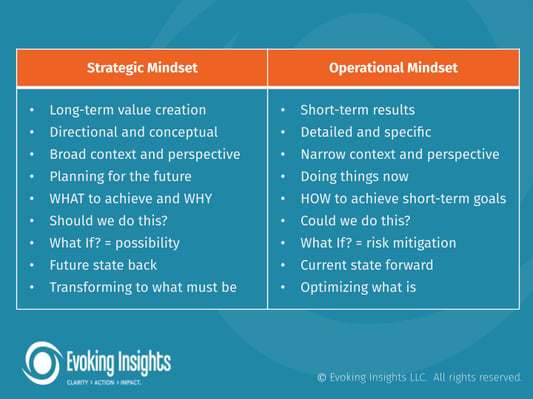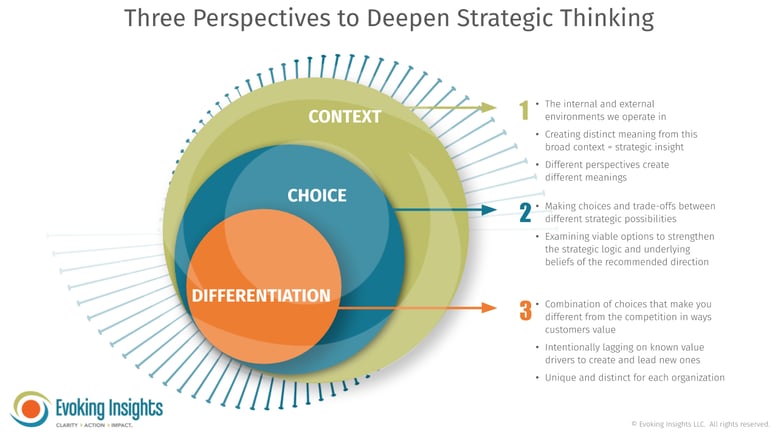Consider these four questions:
- What?
- Why?
- How?
- What if?
Is one of these your go‑to, the first place your mind tends to go when thinking about an opportunity or challenge? For most of my coaching clients, the answer is yes. I use this simple exercise to raise a leader’s awareness to their default mode or mindset.
- HOW people tend to be more operational: Your mind naturally starts to consider how we are going to achieve a goal or metric.
- WHY people tend to be more strategic: You may first ask what are we trying to achieve, quickly followed by “and why”?
Strategy is the underlying logic, the WHY, of our focus and priorities, a WHY that is rooted in your vision for the future.
If your go‑to question is WHAT, or WHAT IF, your default mindset could be either more strategic or more operational, depending on what it means for you.
For example, WHAT IF means possibility for some people. For others, it means risk. And while the strategist may ask, “what are we trying to achieve?” a more operational mindset might ask, “what are we doing?”
Operational vs. Strategic Mindset
Let’s take a look at these two different mindsets in more depth.
An operational mindset is useful, productive. You get things done. Operational thinking tends to be detailed, narrow, and specific and yields short‑term results. Often labeled tactical, it is defining and executing concrete action steps that move the organization closer to its desired future. Leaders with an operational mindset are doing things now, focused on the HOW of achieving short‑term goals.
A strategic mindset is focused on long‑term value creation. It is directional, conceptual, and requires broad context and perspective. It involves high‑level thinking that defines the direction to take, based on the future you envision. That strategic vision informs what must be done now to make that future possible. Strategy is the WHY behind the WHAT.

Strategic leaders have a broad view of the world in which they operate. They are constantly interpreting the landscape and indicators they see, using the insight they gain to actively shape the future. While strategic leaders must embrace ambiguity, uncertainty, and adaptability, operational leaders are rewarded for eliminating ambiguity and delivering predictable, repeatable results through a “well‑oiled machine.”
Both perspectives are needed. Vision without action is just a dream. Action without direction is just activity.
Delivering results is the “ticket to play” for any leader. And the more senior you become, the more your job is to pay attention to the strategic concerns that inform your organization’s long‑term aspirations.
Where do you focus your attention each day? Do you have a default mode?
At your next meeting, notice the following: What mindset are you in? What happens when you shift to the other mindset? How do you see things differently? How does the focus of your attention shift? Notice if you have reverted to your default mindset versus the one that is needed most in that moment.
Building the capacity to flex easily between the two mindsets, to meet the needs of the situation, is invaluable.
Flex Your Strategic Thinking Skills
To flex your strategic thinking skills, reflect on a decision before you. Perhaps it’s a big ask you have around funding, resourcing, or relative priority across a team. In essence, the WHAT.
Now consider these three core perspectives to deepen the strategic thinking and logic, the WHY, that supports your recommendation.
1. Context
Another way to think about it is “big picture.” What is the business objective of your idea?
How does it advance your broader objectives? How does it leverage your organization’s assets, strengths, and capabilities? How does it affect others, both internally and in the outside world?
In essence, what are the key beliefs and strategic insights driving your recommendation?
2. Choice
Success means choosing to do some things and not to do others. But strategic choices are not easy choices. They involve trade‑offs, and sometimes compromises. There is no right answer in strategy, no guarantee of success. How could you frame the options and deepen the rationale behind the recommended trade‑offs? What have you said NO to, for the “hell YES” to your idea?
3. Differentiation
Here’s the ultimate key to business strategy: carving out a place that is different from your competition. On the surface, it sounds simple. But many businesses don’t quite get there. They invent variations on best practices, but they are rarely creating Blue Ocean strategies. These are visionary, market‑creating strategies that create demand, or sometimes entirely new industries. A first place to start is to consider how your recommendation is creating distinct customer value relative to competition.

As you explore each of the three lenses, how might you deepen your thinking to move beyond the known and familiar to distinct strategic insights that make a case for your idea? What might you discover? Perhaps an intuition revealed that you can now explain with a robust strategic logic. What could you add or adapt to be more effective in making your strategic case for investment or focus?
Shifting from Tactical to Strategic Thinking
With awareness comes choice. Begin your shift from the tactical to the strategic by recognizing which mode you are in. Then experiment with strategic thinking, mindsets, and perspectives—balancing future thinking while acting in the now.
Sometimes the biggest obstacle to moving beyond day‑to‑day tasks to the bigger picture is shifting from tactical actions to strategic thinking. You will need to make time to think and get comfortable with the discomfort that may arise with thinking instead of doing.
The effort is worth the reward to amplify your strategic impact. Your strategic thinking skills will demonstrate that you can make decisions that position the organization for the future. It assures senior leaders that you aren't making decisions in a vacuum but are considering how other departments might be affected or how the outside world will respond.



